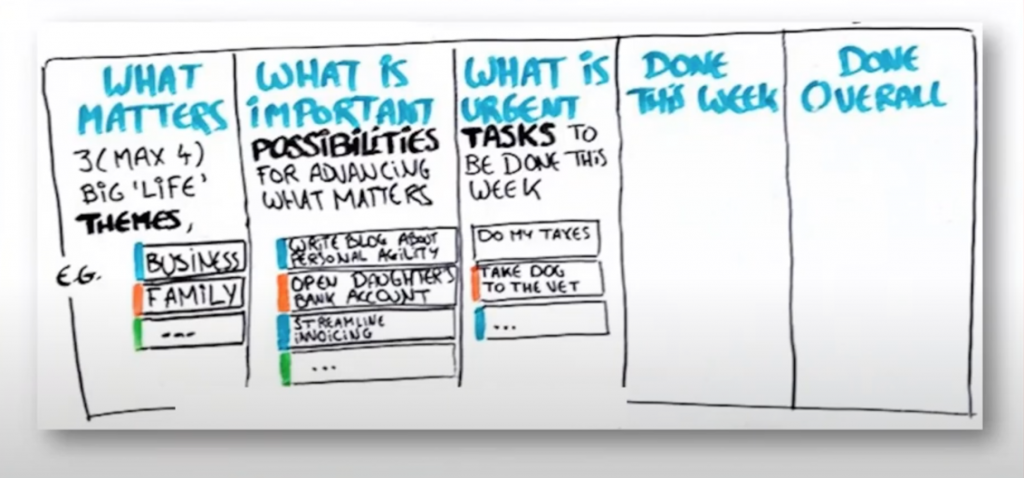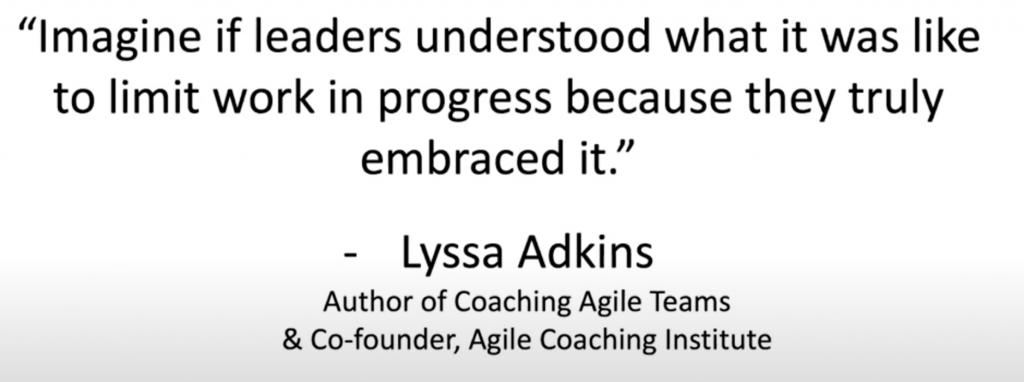We all have blind spots. It turns out that during my journey in the world of Objectives, I stumbled into a parallel world of personal agility. I suppose it had to. Both literally and metaphorically.
But I need to add a bit of context first.
What does it mean to be agile? (A good friend asked me). I think you can only be agile towards an objective or intention, so being agile presupposes you already have a clear objective of some sort. In order to achieve an objective, a degree of agility is required to deal with the changing and unpredictable circumstances that present themselves as soon as you get going! An agile approach is based on empiricism: that is, transparency, inspection and adaptation. And making decisions accordingly.
The route (strategy) towards any objective cannot necessarily be known in advance, and in any case might take too long to find out. As a metaphor, the military strategist, Clausewitz, used the story of a traveller who wants to continue another easy leg of his journey before nightfall – nothing too ambitious – only to find out the horse he wanted to ride is sick, the path is muddy and is actually up a steep mountain, and it’s getting dark. When he does eventually get to the inn, it’s miserable, but he’s glad to be there.
In my own story, I tried to relate how something as ludicrously straight-forward as going on a solo surfing trip round Wales (only slightly more elaborate than a ‘walk in the park’) ended up – despite my utter determination to achieve it – being an almost impossible task to accomplish, with all sorts of roadblocks, glue-pots and distractions thrown in my way.
So, by concentrating on my objectives, and then staying agile towards the objective, that’s how I ended up stumbling into personal agility.
Personal agility
I listened to a talk by Maria Matarelli about Personal Agility. Ah, I was actually implementing a degree of personal agility without even realising it. That, I suppose, was my first blind spot.
Listening to her helped me to refine my approach and start improving my own personal agility.
With her approach, she starts with the question of “what really matters”. The things that matter become your themes. I went about it slightly differently and started with the themes (career, health, spirit, relationships etc.). These were originally my objectives, but – as I came to learn – are in fact themes. She also recommended reducing the themes to a maximum of four.
Then she presented a personal kanban board. I did something similar, but I liked her approach. She had an extra column between ‘themes’ and ‘tasks’ called ‘possibilities’.

That was new for me. So, I’ve now included that extra column.
My own interpretation
I started by calling my column ‘Objectives and opportunities’ and included my top three current objectives into this column (linked to the themes).
Objectives & Opportunities
A friend of mine told me (after reading my previous article) that he won’t be needing any ‘objectives’ in his life, because it’ll stop him being able to take opportunities when they arise. Objectives and opportunities aren’t mutually exclusive. I think that opportunities should be taken if they align with your own objectives – and if not, then is it actually an opportunity?
In my story, I had the opportunity to buy a VW van – it was a great deal but I declined because it wasn’t a priority nor aligned with anything that I was working towards. Despite my strong urges to finally buy my dream van, I just about managed to say ‘no’ since it wasn’t an opportunity (in fact, it was a dumb idea) and thank God I did decline; a genuine opportunity came up a few months later which worked towards a very important objective. Interestingly, in the interim, I used some creativity to satisfy whatever primitive urge was prompting me to want my dream van! That’s a summary of my other article.
But it was nonetheless an important reminder to be able to take advantage of opportunities.
Small bets
Right now, I’m inclined to rename ‘opportunities’ to ‘small bets’. It’s reminder that if something requires a low investment and has more upside than downside, then it’s a small bet.
After listening to some of Annie Duke’s stuff, if we can look at a decision as a bet, we’re in the mindset to analyse more critically and consider the probability of an outcome. And by looking at things probabilistically, we can improve the quality of our decision making.
Perhaps, a lot of this journey has also been about improving decision making – it’s all related. Essentially, “improving decision quality is about increasing our chances of good outcomes, not guaranteeing them” (Annie Dukes) – which is very much in line with personal agility.
Big rocks
Also in the past few months, I stumbled across the work of ‘scrum care-taker’ Gunther Verheyan, and he has sort of become the adopted guru for our Saltwood start-up (seeing as he has an almost uncanny resemblance to both me and Craig). In one of his blog articles, he talked about some of the big rocks on his backlog that he manage to complete.
Big Rocks! I liked that idea too. Some things I had in mind were simply big rocks: big vague ideas or projects somewhere down the line. How do I start slowly shifting them? I wanted to visualise of few of them as well. I expect they’ll turn into an objective or a small bet at some point in the future. Or disappear. Let’s see.
Version 2
So my version 2 of my personal agility board looks like this:

Themes | Objectives, small bets, big rocks | To do | 3 Priorities | Done
In my second column, I’ve got about three of each: three objectives, three small bets and three big rocks.
It might be too much and I might need to amend, but let’s see. At least the big rocks are longer term endeavours, and I’ll just be keeping an eye on them.
For the opportunities, however, I tried to keep them to about a three-month time frame.
Check in
The other thing I learned from Maria, and I adopted, was a proper check in with myself – and to keep to it. As with most things, it’s quite easy to let things slip. So I’ve got a check in now – hopefully, it’ll become habitual.
Why bother with all this?
In summary, one of the key points behind Maria’s talk is that we try, as organisations, to become more agile with the aim of delivering more value to the customer etc etc. And despite all the efforts and contortions, many companies still struggle to become agile organisations. So she asks the question, ‘what if everyone in the company just adopted personal agility?’. Like, starting with the leadership team. Visualising what they’re working on, prioritizing, reducing work in process.

We assume that it’s the organisation that will be agile – and we go to great legnths but then completely forget about ourselves! (The people in the organisation). Not to mention adopting agility in other aspects of our life to achieve some personal objectives.
Blind spots!
If you watch the interview, it’s also leading agile consultants that have these blind spots!
Wrapping up
So, this is where the personal agility can help both in the workplace and in everyday life.
I started applying it to both workplace and everyday life. It doesn’t need to cover to every aspect of your life – just a few things that matter to you. It’s not about doing more, if anything it’s about doing less overall – but doing more of the right things. At it’s most basic, personal agility visualises what’s important and prompts you to prioritize things that will ultimately pull you closer to your objectives.
Recommended links
Maria Materelli interviewed by Agile Centre
Art of stress-free productivity (David Allen)
Addendum: an even bigger blind spot?
The other blind spot we have is the hidden fragility in our lifestyle choices. Many things that appear secure are anything but secure, especially during black swan events.
So, whilst I’ve been looking at personal agility, I’ve started thinking about personal anti-fragility – another blind spot and a new big rock!

